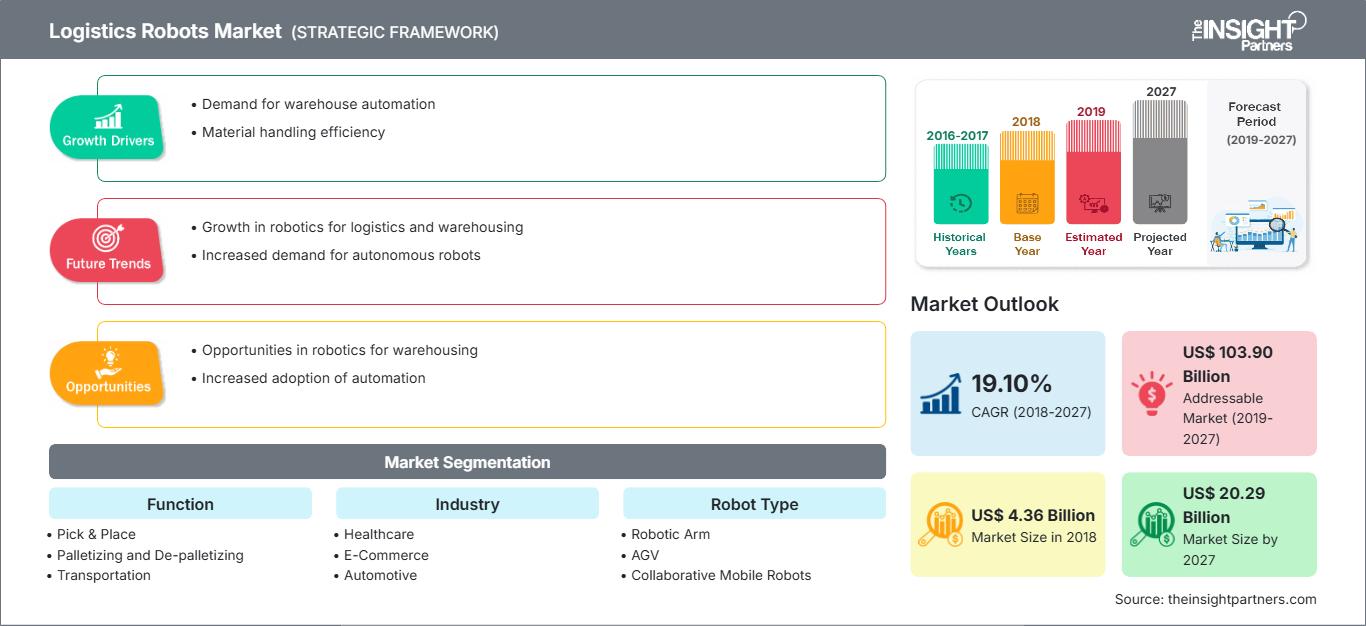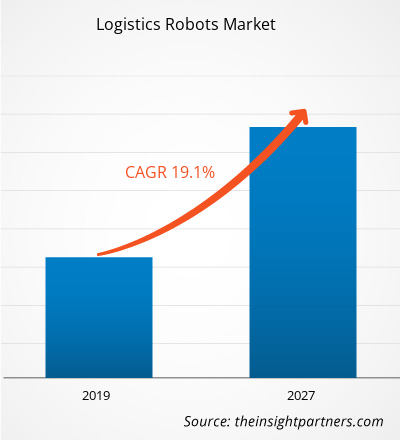2018 年,物流机器人市场价值为 43.562 亿美元,预计 2019 年至 2027 年的复合年增长率为 19.10%,到 2027 年将达到 202.934 亿美元。
越来越多的物流和仓储公司致力于整合机器人,以提高效率、速度和增加利润,从而保持市场竞争力。为了以合理的价格提高运营效率,机器人仓储和物流技术等先进技术的应用正在不断增长。全球物流机器人市场受到全球老龄化人口比例不断上升导致劳动力短缺以及全球供应链网络不断扩大等因素的驱动,但预计在预测期内,部署物流机器人的高资本投入将抑制物流机器人市场的增长。然而,亚太地区和欧洲国家日益增长的仓库自动化和成熟的市场很可能在不久的将来为行业参与者带来巨大的增长机会,从而提高市场份额。
市场洞察 全球老龄人口比例不断增长导致劳动力短缺
全球老龄人口比例不断增长是各行各业劳动力减少的主要因素之一。世界各国都目睹了其社区老年人口数量的激增。人口老龄化已经成为21世纪社会转型的重要因素之一,涵盖劳动力和金融市场。不过,意大利、日本等许多国家是老龄人口比例最高的国家,65岁以上的人口占比相当大。据世界卫生组织预测,到2050年,全球将有约200万人年龄超过60岁,是2000年的三倍。老龄人口数量的激增导致了劳动力短缺。在多个行业中实施物流机器人发挥着重要作用,因为它可以降低流程的总体成本、提高生产率、增强安全性并减少人为错误。全球仓库技术的快速进步专注于解决供应链流程面临的困难相关的需求,并确保所使用的技术与业务目标相关。在产品生命周期的不同单元、功能和阶段中实施机器人一直是当今仓库在其增长道路上面临的关键挑战,这反过来将在不久的将来推动物流机器人市场的发展。
自定义此报告以满足您的要求
您将免费获得任何报告的定制,包括本报告的部分内容,或国家级分析、Excel 数据包,以及为初创企业和大学提供超值优惠和折扣
物流机器人市场: 战略洞察

-
获取本报告的主要市场趋势。这个免费样本将包括数据分析,从市场趋势到估计和预测。
协作移动机器人在全球物流机器人市场中占据最大份额。它们被部署到各行各业,执行包装、机器操作和物料搬运等多项任务,因为这些协作机器人足够熟练,能够处理重载和轻载操作。它们高度精确、灵活且精准。此外,协作机器人易于维护,并且更易于重新配置和重新编程。这些机器人还可以处理敏感工作;此外,它们还会根据制造过程中出现的不一致情况进行自我调整。协作机器人能够收集关键指标,用于提供机载分析和报告,从而简化决策过程,推动整个物流机器人市场的发展。
功能洞察
运输领域在全球物流机器人市场中占据最大份额。货物采用托盘运输,并且某些产品的形状和尺寸略有不同,因此需要实现货物装卸的自动化。 3D激光视觉与新型机器人软件集成,可帮助用户查看集装箱内的不同产品,确定理想的装卸顺序,并高精度地执行整个流程。物流机器人可用于移动目标货架、拉起和提升篮筐、在货架上伸展货叉以及返回目标位置,推动着整个物流机器人市场的发展。
行业洞察
外包物流领域在全球物流机器人市场中占据最大份额。这些物流服务提供商提供各种服务,包括仓储、库存管理、运输、配送、订单履行和货运整合。对及时交付管理和降低运输成本的需求不断增长,这增强了对库存物料记录的关注,以及核心业务和公司资产减少,预计这些因素将在预测期内推动物流机器人市场的发展。
企业通常会采用多种市场主动战略来扩大其全球影响力并满足不断增长的需求。这一策略主要在欧洲和亚太地区实施。物流机器人市场的参与者采取扩张和投资研发的策略,以扩大全球客户群,这也使得参与者能够在全球范围内维护其品牌。
物流机器人市场区域洞察
The Insight Partners 的分析师已详尽阐述了预测期内影响物流机器人市场的区域趋势和因素。本节还讨论了北美、欧洲、亚太地区、中东和非洲以及南美和中美洲的物流机器人市场细分和地域分布。
物流机器人市场报告范围
| 报告属性 | 细节 |
|---|---|
| 市场规模 2018 | US$ 4.36 Billion |
| 市场规模 2027 | US$ 20.29 Billion |
| 全球复合年增长率 (2018 - 2027) | 19.10% |
| 历史数据 | 2016-2017 |
| 预测期 | 2019-2027 |
| 涵盖的领域 |
By 功能
|
| 覆盖地区和国家 |
北美
|
| 市场领导者和主要公司简介 |
|
物流机器人市场参与者密度:了解其对业务动态的影响
物流机器人市场正在快速增长,这得益于终端用户需求的不断增长,而这些需求的驱动因素包括消费者偏好的演变、技术进步以及对产品优势的认知度的提升。随着需求的增长,企业正在扩展产品线,不断创新以满足消费者需求,并抓住新兴趋势,从而进一步推动市场增长。

- 获取 物流机器人市场 主要参与者概述
- 机械臂
- AGV
- 协作移动机器人
- 其他
物流机器人市场 — 按功能
- 拾取和放置
- 码垛和拆垛
- 运输
- 包装
物流机器人市场 — 按行业
- 医疗保健
- 电子商务
- 汽车
- 外包物流
- 零售
- 消费品
- 食品和饮料
- 其他
物流机器人市场 —
- 按地理位置
-
北美洲
- 美国
- 加拿大
- 墨西哥
-
欧洲
- 法国
- 德国
- 意大利
- 英国
- 俄罗斯
- 欧洲其他地区
-
亚太地区
- 中国
- 印度
- 韩国
- 日本
- 澳大利亚
- 亚太其他地区
-
中东和非洲
- 南非
- 沙特阿拉伯
- 阿联酋
- 中东和非洲其他地区
-
南美洲
- 巴西
- 阿根廷
- 南美洲其他地区
公司简介
- AGV International
- Clearpath Robotics
- Daifuku Co. Ltd.
- Fanuc Corporation
- Fetch Robotics Inc.
- Kion Group AG
- KNAPP AG
- Kollmorgen
- KUKA AG
- Toshiba Corporation
- 历史分析(2 年)、基准年、预测(7 年)及复合年增长率
- PEST和SWOT分析
- 市场规模、价值/数量 - 全球、区域、国家
- 行业和竞争格局
- Excel 数据集
近期报告
相关报告
客户评价
购买理由
- 明智的决策
- 了解市场动态
- 竞争分析
- 客户洞察
- 市场预测
- 风险规避
- 战略规划
- 投资论证
- 识别新兴市场
- 优化营销策略
- 提升运营效率
- 顺应监管趋势






















 获取免费样品 - 物流机器人市场
获取免费样品 - 物流机器人市场